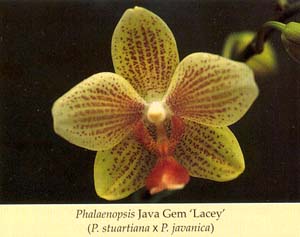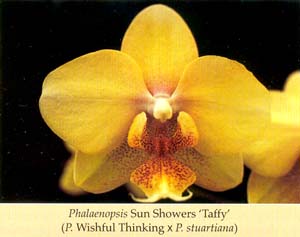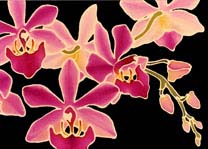Hybridizing with Phalaenopsis Species
by Bill Livingston
Phalaenopsis stuartiana
|
This species has outstanding gray-green marble colored leaves with reddish purple undersides, making it attractive even when out of bloom. If you want 50 to 100 flowers at one time, this is the plant to own. The plant has small white flowers; the lip and central part of the petals can be spotted mahogany red, with the same, but solid, color on the ventral sepals. Some clones are almost pure white. The standard form of this species is easy to hybridize, as its pollen can be used for self-pollination or crossing with other species. It certainly increases the flower count. Although its shape is not always the best, when crossed with a full- shaped flower it certainly can help to produce better shaped flowers.
I would like to express an opinion based on my observations and from talking with other hybridizers about P. stuartiana 'Larkin Valley' AM/AOS. It has been an outstanding breeding plant for many years, producing many fine hybrids, and it has been known to breed like a tetraploid. This plant originally came from Arthur Freed Orchids, and was sold to John Ewing Orchids who received the AM/AOS. It had the darkest plum red spotting to blotches on the petals and ventral sepals to the point it was almost solid color on the inner sides of the sepals. A few of us hybridizers do not believe this clone to be pure P. stuartiana. The reason is that Herb Hager and John Ewing made a sibling cross using 'Larkin Valley' with a white, not heavily marked clone. When I observed the cross blooming for the first time at Herb's nursery, he pointed out to me the variation in the leaf coloration; the leaves of some clones were mottled and others pure green. Some had rounder leaves than the typical pointed leaf of the wild-collected species. Another difference was that all those with non-patterned leaves had white flowers which were much larger than the spotted and patterned flowers. Herb's opinion was that one of the parents was not a pure species, and this opinion was shared by several other hybridizers. It still is worth using if you want lots of branching and many flowers, but in my opinion it is not a true species.
|


|



This article which has been reprinted here with permission, originally appeared in the Volume 66, Number 4 edition of Orchid Digest, (Oct-Dec 2002), which is a Special Edition that highlights Phalaenopsis, and also features an excellent article on Phal culture by the Tuskes. The Phalaenopsis Special Edition of Orchid Digest can be ordered from Orchid Digest for $22. Highly recommended.
This article, all of its sections and accompanying photographs
are copyright 2002 by Orchid Digest Corporation.
Note: This site uses Javascript Navigation Controls;
if you have Javascript disabled on your Browser,
you will need to use the Site Map to navigate this site.
|



